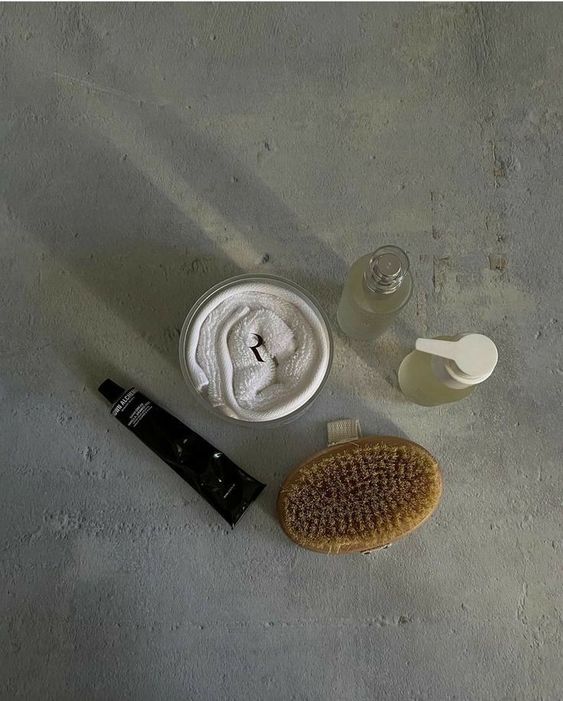
Knowing your skin’s type is crucial knowledge for your overall well-being on an internal and external level. The 4 main types of skin include: normal, dry, oily, and combination. By identifying your skin’s type, you will learn how to take better care of it, and identify the internal and external factors that affect each skin type.
Many experts claim that downsizing the classification of the skin to only 4 types could turn out to be extremely limiting for diagnosis and product/treatment recommendation
purposes. Characteristics such as proneness to hyperpigmentations and aging are left out of the conversation. Not to mention that some people with dry skin do develop impurities, and oily complexions could also become sensitive. We get that, but when we talk about the skin types we are focusing only on the imbalances of the acid mantle. Yes, that protective mixture of sebum, water and dead skin cells. So, depending on the ratio of water and oil present in our natural emulsion, we can determine if someone has normal, dry, oily or combination skin. The other issues like acne, wrinkles, melasma, reactivity, etc., are actually conditions that everyone can experience at some point in their lives, but they are not a skin type per se.
We are advocates of keeping things simple, and skin classification is not an exemption. It is possible to achieve healthy looking skin by restoring balance to the acid mantle and adding a few extra elements to address the different conditions. Skincare doesn't have to be extremely complicated. Non-practical approaches can potentially discourage you and confuse you even more. Staying true to our educational nature, we have put together a simple guide that will help you easily identify your skin type. Which checklist seems to describe your skin type better?
Normal Skin Checklist: Your Go-To Reference Guide
- It's also called eudermic or porcelain skin because it is the only one with a perfect sebaceous/sweat secretory balance: this translates into a well constituted O/W (oil/water) or W/O (water/oil) emulsion.
- It is easily recognizable as the barrier function is not altered and is always well-hydrated.
- It has few or no imperfections.
- It has a uniform rosy complexion.
- It is plump, supple and elastic.
- It is smooth and soft/velvety to the touch.
- It is moderately thick with a proper blood flow.
- It has a glowy (non-greasy) appearance with fine pores.
- It tolerates soaps well and does not flake.
- It is highly resistant to temperature changes and environmental aggressors.
- Typically found in babies and young people.
- As it ages, it does not experience major changes with regards to oil/water levels.
- Some experts claim that normal skin is an “illusion” because we all experience skin imbalances at some point in our lives.
Dry Skin Checklist: Your Go-To Reference Guide
- Skin can be dry due to a reduced quantity of lipids (alipic skin) or water (dehydrated skin). Usually, both states coexist and this condition is medically known as xerosis cutis[2].
- The activity of the sebaceous glands is severely diminished, which has a detrimental effect on the skin barrier/protective function.
- Transepidermal Water Loss (TEWL) on the outermost layer of the skin is a result of diminished sebum secretion, which locks in water, and/or exposure to external factors such as weather, detergents etc., that strip the skin of its protective oils.
- Dry skin pores are almost invisible.
- It has a lackluster/matte appearance and feels tight.
- This skin type is very thin and rough to the touch.
- It has a tendency to wrinkle and suffer from loss of elasticity.
- It is prone to cracks, itchiness, flakiness, keratin build-up, thread veins and irritation.
- It does not tolerate soaps well and is highly sensitive to temperature changes/environmental aggressors.
- Typically found in mature individuals and atopic dermatitis patients.
External Circumstances That Govern Your Dry Skin
- Intense and persistent heat: negatively impacts the water content of the acid mantle through evaporation.
- Intense and persistent cool weather: also causes evaporation of the water content of the skin, which in turn inhibits the action of enzymes that break down skin proteins into the amino acids that form the natural moisturizing factor (NMF)[3].
- UV radiation: damages skin lipids and proteins.
- Swimming in chlorinated water and/or during long periods of time.
- Taking hot and/or long showers or baths.
- Soaps/detergents and formulas with an alkaline pH: they strip the skin off the natural oils —which is naturally acidic—that protect them and help bind its cells.
Internal Circumstances That Govern Your Dry Skin
- Age: sebum and sweat secretions usually diminish during this stage of our lives.
- Genetics: can make our skin produce reduced concentrations of the oil and water components of the acid mantle.
- Diseases: such as atopic dermatitis, psoriasis, ichthyosis (fish skin disease) and hormonal imbalances (especially those associated with the thyroid).
- Medications: antihistamines, chemotherapy, diuretics, retinoids (acne drugs), statins (“bad” cholesterol-regulating drugs)[4].
- Smoking: causes the skin to dry by diminishing blood flow and causing constriction of blood vessels, hence nutrients are not delivered when and where needed[5].
Oily Skin Checklist: Your Go-To Reference Guide
- This skin type is characterized by overactive sebaceous glands which are responsible for the secretion of sebum, the skin's natural lubricant and protective agent.
- It is soft and sticky to the touch.
- It is thick with an overall greasy and shiny appearance.
- It has very large pores and is prone to all sorts of blemishes, even the embedded ones like cysts. These blemishes can result in pigmentation issues and scars.
- It is usually well-moisturized and develops few wrinkles.
- It tolerates soaps as well as temperature changes/environmental aggressors.
- Excessive cleansing and usage of alkaline/astringent formulas will strip oily skin off its natural lipids and further increase sebum secretion.
- Typically found in men and youngsters.
External Circumstances That Govern Your Oily Skin
- Overwashing the skin or overusing formulas/ingredients that alter its pH like scrubs, chemical peels, etc.
- High temperatures can stimulate sebum secretion: spending long periods of time outdoors without protection, taking hot showers/baths, using the sauna or tanning booths, etc.
Internal Circumstances That Govern Your Oily Skin[6]
- Genetic predisposition.
- Changes in sebum composition.
- Abnormal proliferation of keratinocytes and P. acnes bacteria in the follicle.
- Tobacco: nicotine promotes non-comedogenic acne.
- Diet: high glycemic and dairy foods promote oily skin and acne because they increase insulin and insulin-like growth factor.
- Hormones: elevated concentrations of estrogens (estriol, estradiol) and androgens (testosterone, dihydrotestosterone, etc.).
- Stress: raises levels of cortisol which, in turn, promote inflammation.
- Drugs/supplements: ciclosporin, lithium, benzodiazepines, iodides, isoniazid, ramipril, epidermal growth receptor inhibitors, serotonin uptake inhibitors, contraceptive implants with etonogestrel or levonorgestrel, corticosteroids, vitamin B-complexes.
- Diseases: polycystic ovarian syndrome, tumors of the endocrine system, late congenital adrenal hyperplasia and dysfunction, obesity, hyperinsulinemia and insulin resistance.
Combination Skin Checklist: Your Go-To Reference Guide
- This skin type has very marked oily (T-zone) and dry areas (U-zone).
- Given its unique nature, combination skin is the most challenging one to bring back to balance.
- Whereas the T-zone comprises the forehead and nose (sometimes the chin too), whereas the U-zone is located at the cheeks and chin.
- The T-zone has the same characteristics of an oily complexion: greasy, shiny, sticky, thick, with large pores and impurities.
- The U-zone has the same characteristics of a dry complexion: dull, rough, flaky, thin, sensitive, with invisible pores, predisposition to premature aging, etc.
- Although it is rare, complexions with a normal T-zone area and an extremely dry U-zone area can also be classified as combination skin.
- The best approach for taking care of combination skin is to use pH-balanced products that target at the same time both oily and dryness needs (multitasking), instead of using different formulas for the different zone imbalances. As an extra step, make sure you apply a balancing toner (alcohol-free) on the T-zone and a face oil on the U-zone.
- For internal and external factors that affect combination skin, review the dry and oily checklists.
Identify Your Skin Type: Two Simplified Tests
Evening Assessment To Identify Your Skin Type
Observe how your skin looks and feels at the end of the day:
- Normal skin: feels soft and looks glowy.
- Dry skin: feels tight and looks dull, flaky and/or irritated.
- Oily skin: the whole complexion looks shiny and is greasy to the touch.
- Combination: shiny/greasy on the T-zone; matte and tight on the U-zone.
Overnight Assessment To Identify Your Skin Type
- Wash your face with a mild cleanser.
- Pat dry.
- Do not apply any products.
- Go to sleep
- When you wake up, dab your skin with a blotting paper or a tissue (forehead, nose, cheeks and chin). Check for the following patterns:
- Normal skin: the paper/tissue will stay on the skin for a few seconds and then fall off with no oil residue.
- Dry: the paper/tissue will immediately fall off the skin with no traces of oil at all. The difference with normal skin is dry skin will feel super tight in the morning and might start peeling and showing irritation signs.
- Oily skin: the paper/tissue will easily stick to all areas of the skin and have traces of oil.
- Combination: the paper/tissue will only stick easily and show oil spots on the T-zone.
- Do not perform the skin test if you recently underwent a cosmetic procedure or plastic surgery. Wait until your complexion has fully healed.
- It is important that 1-2 weeks before the test you avoid using the following: alcohol, acids, abrasive exfoliants, highly alkaline formulas, retinoids, harsh cleansers and synthetic fragrances. This will help reveal your true skin type.
To conclude, recognizing and pinpointing your skin type can help you better understand how to take care of it and the external and internal factors that ultimately shape it. To learn more about your skin and get the deets on how to achieve beautiful skin, make sure to follow us on our Instagram, Facebook, Pinterest, and Linkedin platforms.
References
[1] https://www.ncbi.nlm.nih.gov/pmc/articles/PMC7167948/
[2] https://onlinelibrary.wiley.com/doi/10.1111/ddg.13906
[3] https://metro.co.uk/2019/02/01/cold-weather-wrecking-skin-fix-8425443/
[4] https://www.singlecare.com/blog/medications-that-cause-dry-skin/




